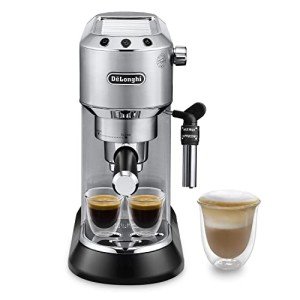Energy-Efficient Espresso Machines: A Comprehensive Guide
On the planet of coffee enthusiasts, espresso machines are frequently concerned as necessary appliances for developing rich, fragrant coffee. However, please click the next website page related to these machines can cause increased utility costs and ecological issues. As customers become more eco-conscious, energy-efficient espresso machines have become a popular option. This article intends to check out the functions, benefits, and options available in energy-efficient espresso machines, helping coffee lovers make notified options.
What Makes an Espresso Machine Energy-Efficient?
Energy-efficient espresso machines are created to lessen energy intake while preserving optimal efficiency. Numerous features add to the energy effectiveness of these machines:
- Insulation: High-quality insulation assists keep heat, lowering the energy needed to keep ideal brewing temperatures.
- Smart Technology: Many modern machines are geared up with programmable settings that allow users to arrange brewing times and switch to standby mode when not in use.
- Quick Heat-up Time: Energy-efficient espresso machines often use innovative heating technologies, such as thermoblocks or PID controllers, to heat water quickly.
- Low Wattage: Machines that run at lower wattages consume less energy in general, making them more efficient.
- Automobile Shut-off: Automatic shut-off features guarantee that the machine switches off after a specific duration of inactivity, further decreasing energy waste.
Advantages of Energy-Efficient Espresso Machines
Buying an energy-efficient espresso machine can provide several benefits:
- Cost Savings: Over time, lower energy consumption can cause minimized electrical energy costs.
- Environmental Impact: Using less energy lowers carbon footprints, making these machines a more sustainable option for ecologically mindful consumers.
- Improved Performance: Many energy-efficient models likewise offer exceptional developing technologies, leading to better-tasting espresso.
- Durability: Typically, energy-efficient machines are constructed with high-quality elements, leading to higher durability.
Features to Consider
When picking an energy-efficient espresso machine, numerous functions ought to be taken into consideration:
- Type of Machine: Options include manual, semi-automatic, and totally automatic models, each with differing degrees of user control and automation.
- Brew Quality: Look for machines that make use of high-quality developing systems to ensure ideal flavor extraction.
- Upkeep: Some machines have self-cleaning functions that can conserve energy and effort in upkeep.
- Capacity: Depending on personal or household size, machine capability can affect energy consumption, with bigger machines often needing more power.
Popular Energy-Efficient Espresso Machines
The market uses a variety of energy-efficient espresso machines accommodating different needs and choices. Below are some noteworthy models:
| Brand | Model | Secret Features | Energy Consumption |
|---|---|---|---|
| Breville | Barista Express | Integrated grinder, PID temperature level control, fast heat-up. | Low |
| DeLonghi | EC155 | Compact size, simple to use, long lasting develop. | Moderate |
| Rancilio | Silvia | Durable style, excellent temperature stability, and has a low ecological effect. | Moderate |
| Gaggia | Timeless | Dependable manual operation, durable brass components, and efficient steaming capability. | Low |
| Jura | E8 | Fully automatic, smart features, and a removable brew group for simple cleaning. | Low |
Tips for Optimal Energy Efficiency
Aside from selecting an energy-efficient model, consumers can embrace several practices to optimize energy efficiency:
- Preheat: If your machine has a pre-heating function, use it to ensure that the optimum temperature level is reached rapidly before developing.
- Shut off After Use: Always switch off the machine after brewing or use machines with vehicle shut-off features.
- Routine Maintenance: Keep the machine properly maintained to guarantee it operates efficiently and successfully.
FAQs About Energy-Efficient Espresso Machines
1. Are energy-efficient espresso machines more pricey?
While the initial investment might be greater for energy-efficient models, the long-term cost savings on electrical energy bills can balance out the initial cost. Additionally, lots of energy-efficient machines featured sophisticated functions that boost the brewing experience.
2. How do I know if an espresso machine is energy-efficient?
Try to find indications such as Energy Star accreditation, user reviews, and specifications relating to wattage and heat-up time. Machines with specific features aimed at decreasing energy usage are typically developed for better efficiency.
3. Can I use an energy-efficient espresso machine for other coffee designs?
Lots of energy-efficient espresso machines use flexibility, permitting users to brew various coffee designs beyond espresso, such as lattes and coffees, by incorporating steaming capabilities.
4. Do energy-efficient models sacrifice quality for performance?
Not necessarily. Lots of energy-efficient espresso machines are equipped with high-quality brewing technology that can boost taste extraction while decreasing energy intake.
5. What upkeep is needed for energy-efficient espresso machines?
Regular maintenance involves cleaning the machine, descaling when needed, and periodically checking seals and gaskets to guarantee optimal performance and energy performance.
Energy-efficient espresso machines represent an ideal mix of performance, cost savings, and environmental duty. By considering different functions, benefits, and brands, customers can select a design that fits their unique preferences while contributing favorably to the environment. As the trend towards sustainable living grows, the popularity of energy-efficient devices, including espresso machines, is most likely to continue its upward trajectory, offering coffee lovers a guilt-free way to enjoy their day-to-day dosage of espresso.

